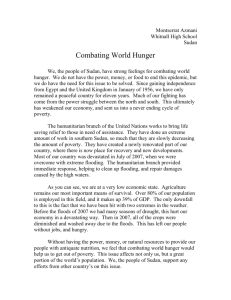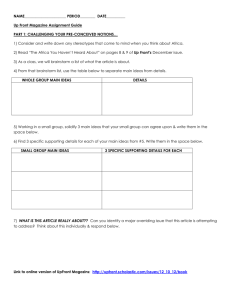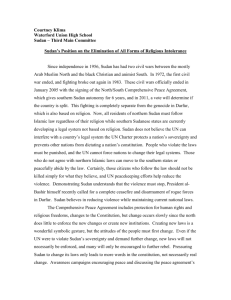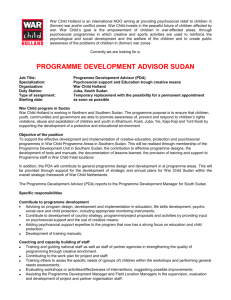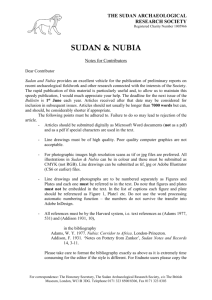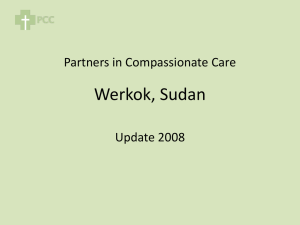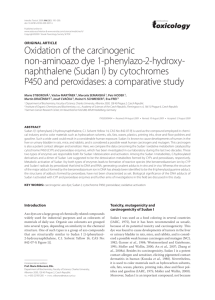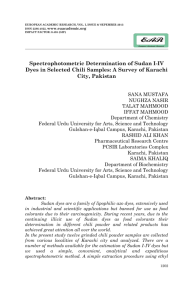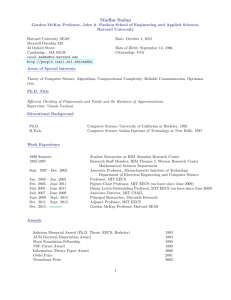Water Resources in Southern Sudan
advertisement
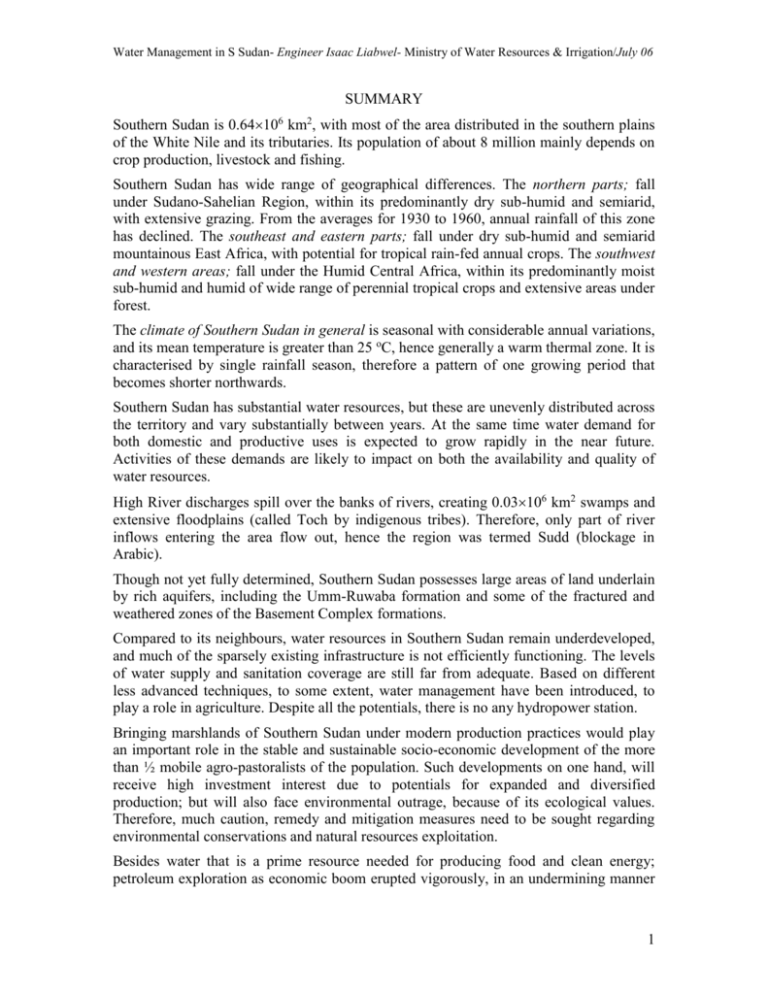
Water Management in S Sudan- Engineer Isaac Liabwel- Ministry of Water Resources & Irrigation/July 06 SUMMARY Southern Sudan is 0.64106 km2, with most of the area distributed in the southern plains of the White Nile and its tributaries. Its population of about 8 million mainly depends on crop production, livestock and fishing. Southern Sudan has wide range of geographical differences. The northern parts; fall under Sudano-Sahelian Region, within its predominantly dry sub-humid and semiarid, with extensive grazing. From the averages for 1930 to 1960, annual rainfall of this zone has declined. The southeast and eastern parts; fall under dry sub-humid and semiarid mountainous East Africa, with potential for tropical rain-fed annual crops. The southwest and western areas; fall under the Humid Central Africa, within its predominantly moist sub-humid and humid of wide range of perennial tropical crops and extensive areas under forest. The climate of Southern Sudan in general is seasonal with considerable annual variations, and its mean temperature is greater than 25 oC, hence generally a warm thermal zone. It is characterised by single rainfall season, therefore a pattern of one growing period that becomes shorter northwards. Southern Sudan has substantial water resources, but these are unevenly distributed across the territory and vary substantially between years. At the same time water demand for both domestic and productive uses is expected to grow rapidly in the near future. Activities of these demands are likely to impact on both the availability and quality of water resources. High River discharges spill over the banks of rivers, creating 0.03106 km2 swamps and extensive floodplains (called Toch by indigenous tribes). Therefore, only part of river inflows entering the area flow out, hence the region was termed Sudd (blockage in Arabic). Though not yet fully determined, Southern Sudan possesses large areas of land underlain by rich aquifers, including the Umm-Ruwaba formation and some of the fractured and weathered zones of the Basement Complex formations. Compared to its neighbours, water resources in Southern Sudan remain underdeveloped, and much of the sparsely existing infrastructure is not efficiently functioning. The levels of water supply and sanitation coverage are still far from adequate. Based on different less advanced techniques, to some extent, water management have been introduced, to play a role in agriculture. Despite all the potentials, there is no any hydropower station. Bringing marshlands of Southern Sudan under modern production practices would play an important role in the stable and sustainable socio-economic development of the more than ½ mobile agro-pastoralists of the population. Such developments on one hand, will receive high investment interest due to potentials for expanded and diversified production; but will also face environmental outrage, because of its ecological values. Therefore, much caution, remedy and mitigation measures need to be sought regarding environmental conservations and natural resources exploitation. Besides water that is a prime resource needed for producing food and clean energy; petroleum exploration as economic boom erupted vigorously, in an undermining manner 1 Water Management in S Sudan- Engineer Isaac Liabwel- Ministry of Water Resources & Irrigation/July 06 to land surface economic activities including wet and farm lands. This is an additional pressure in balancing development alternatives with environmental requirements. On social note, when a decision is reached to embark on a modern development project or a new economic activity such as Jonglei Canal and oil exploration, the masses of Southern Sudan outraged in protest against such. In fact, it appears always a fear of unknown change by the grassroots that some thing may go wrong and the handful of supporters do base their support on promises and pledges of gains. Indeed, the people of Southern Sudan are never privileged to exercise their right to be sensitized and decide on major investment interventions on own resources. These are populations whose skills and capacities are not enhanced in any way, therefore must doubt tangible benefits from high tech scenarios, unless it is made known and guaranteed to them, how much they should compromised and what will be a substitute. Transparency (promotion of information sharing) is vital for water resource management, because it can help in allocation and regulation; since not all areas/countries that need certain amounts of waters at the same times. For instance: Genuine reporting of an adequate rainfall in the upstream areas with supplementary irrigation; could allow downstream users to benefit from the upstream shares. In turn upstream users could delay downstream flows for hydropower generation. Acknowledgement of the occurrence of a dry year could allow more drawing upstream, and the downstream could supplement from the storage. Therefore, there should be no spirit of competition, but cooperation. Southern Sudan is currently emerging from a conflict that nearly resulted in a complete breakdown of basic infrastructure and institutions of governance. While there are a number of different agencies and organisations, including governments and nongovernmental actors, working in water sector; there exists no coherent policy to guide use and management of water resources. The importance of improved understanding of the nature and dynamics of water resource and existing patterns of demand. In addition to its effective management and utilisation, for improving welfare and productivity of the people of Southern Sudan, so as to redress past inequalities and deficiencies in accessing and utilising natural resources is widely recognised. There is currently a severe lack of adequate data and information relating to the availability and use of water resources in Southern Sudan; and local capacities and skills for operating and maintaining water systems are either weak/poor or absent. Rapid rehabilitation and installation of water infrastructure to deliver quality water services; and efficient development and management of water resources for productive uses: Would represent a highly visible sign of progress and a tangible ‘peace dividend’; and would be of central importance for future economic growth in Southern Sudan. As government begins to take shape there is an urgent need for MWRI, to establish a Research Unit, to carryout researches and studies pertaining to hydraulics, hydrology, irrigation development and optimal use of water resources. Findings of the envisaged research department will be used to solve problems related to development of criteria and methods for the protection and conservation. 2

